Cite this document
(“Aviation System Safety Assignment Example | Topics and Well Written Essays - 2000 words”, n.d.)
Aviation System Safety Assignment Example | Topics and Well Written Essays - 2000 words. Retrieved from https://studentshare.org/engineering-and-construction/1499386-aviation-system-safety
Aviation System Safety Assignment Example | Topics and Well Written Essays - 2000 words. Retrieved from https://studentshare.org/engineering-and-construction/1499386-aviation-system-safety
(Aviation System Safety Assignment Example | Topics and Well Written Essays - 2000 Words)
Aviation System Safety Assignment Example | Topics and Well Written Essays - 2000 Words. https://studentshare.org/engineering-and-construction/1499386-aviation-system-safety.
Aviation System Safety Assignment Example | Topics and Well Written Essays - 2000 Words. https://studentshare.org/engineering-and-construction/1499386-aviation-system-safety.
“Aviation System Safety Assignment Example | Topics and Well Written Essays - 2000 Words”, n.d. https://studentshare.org/engineering-and-construction/1499386-aviation-system-safety.


